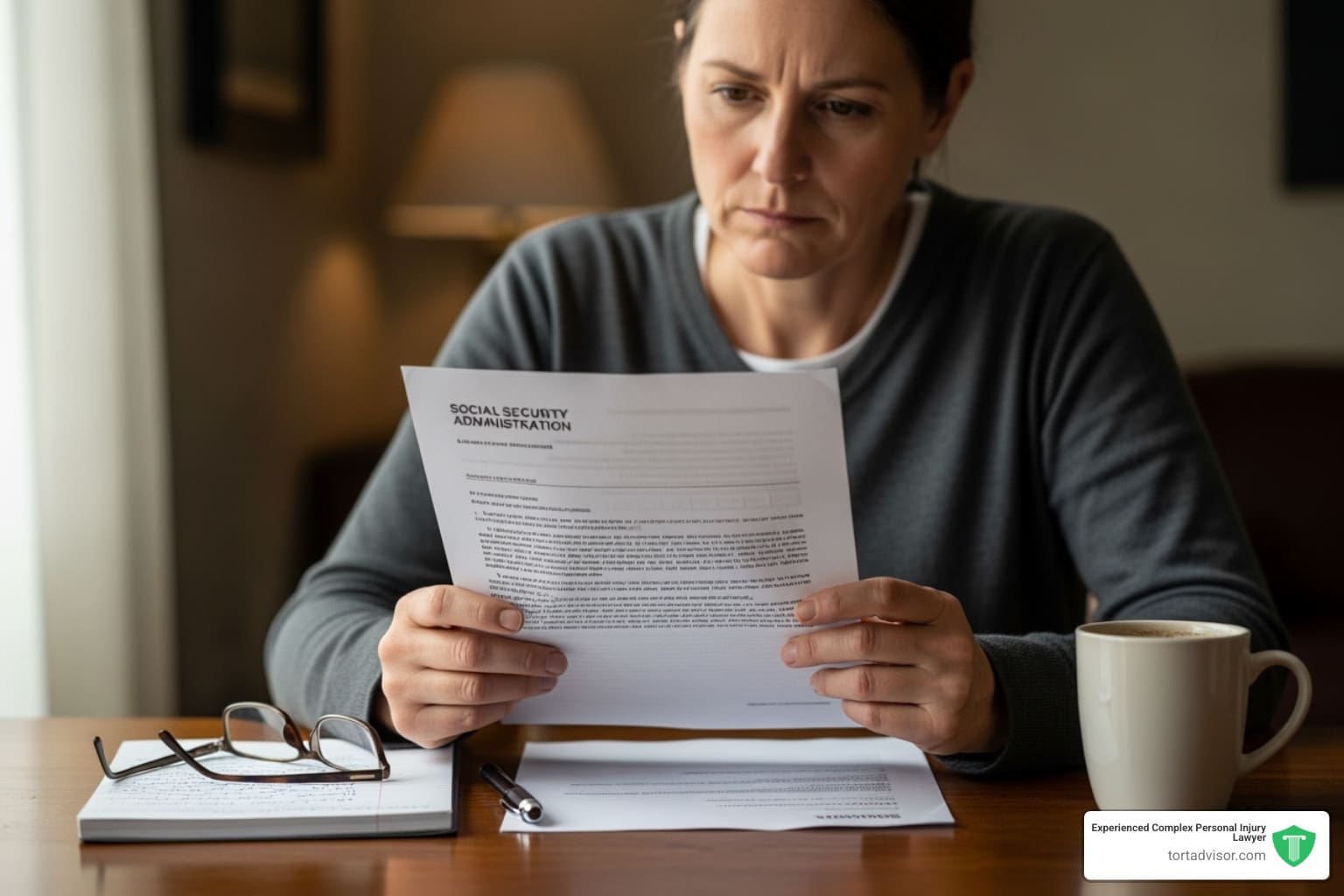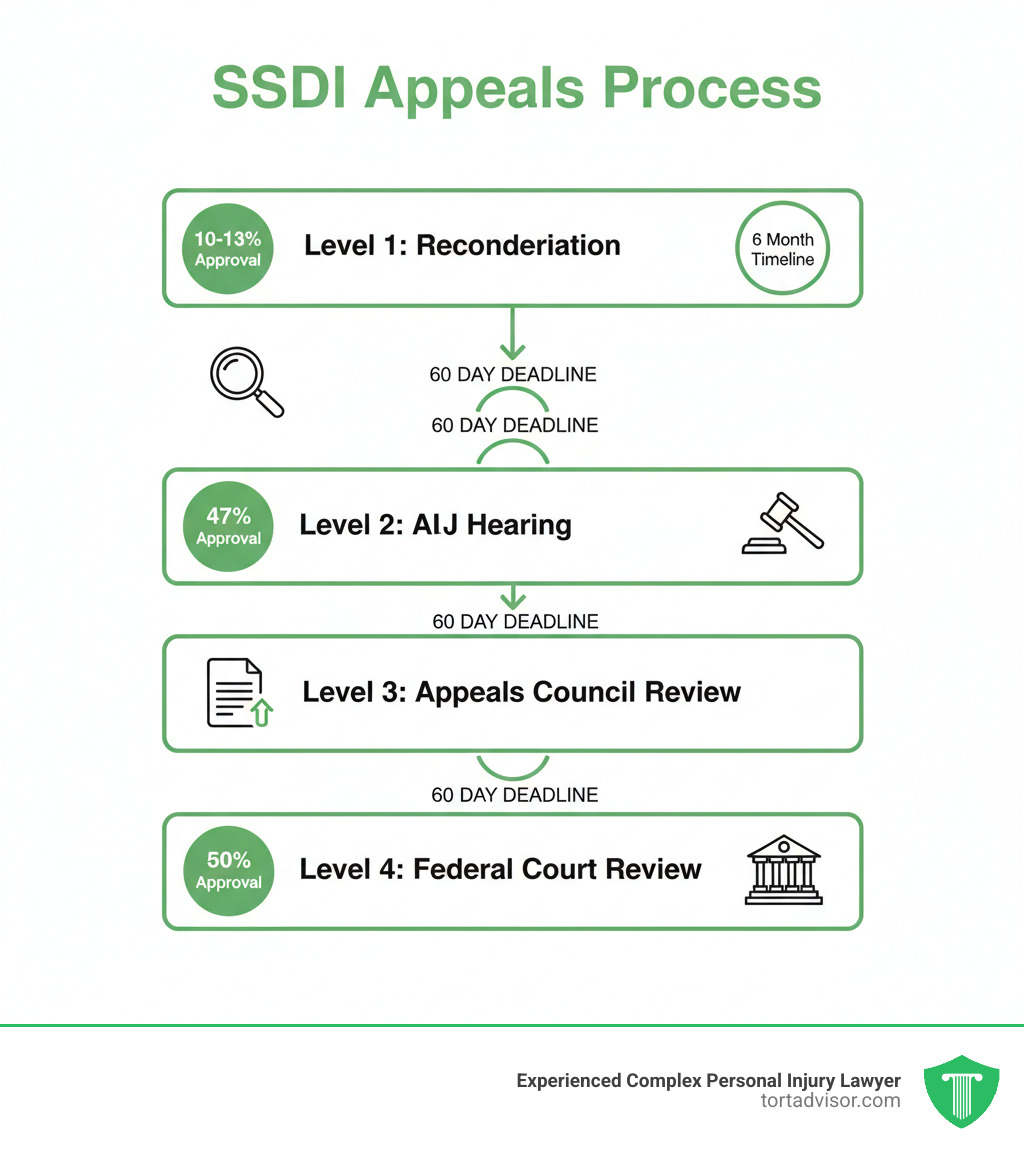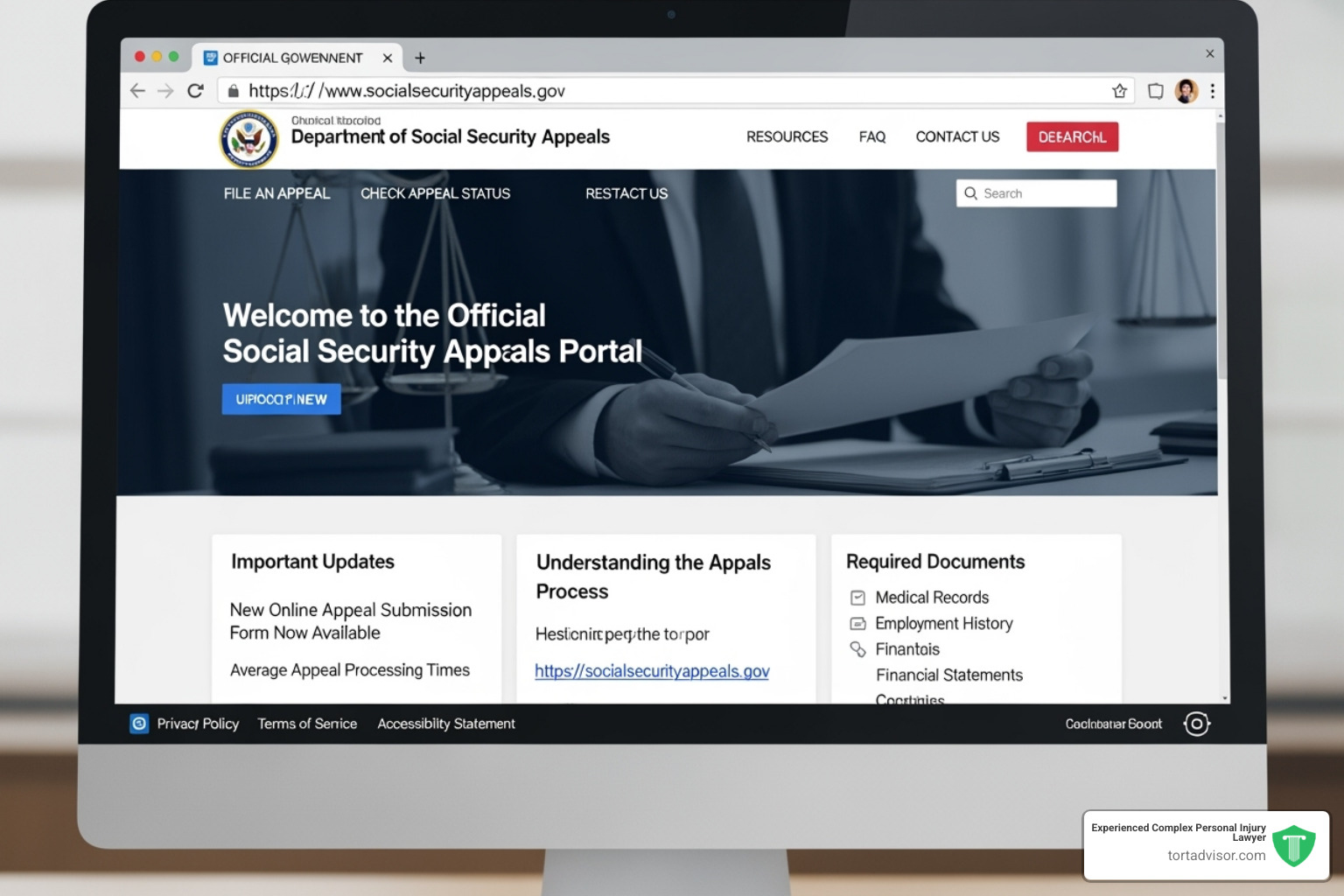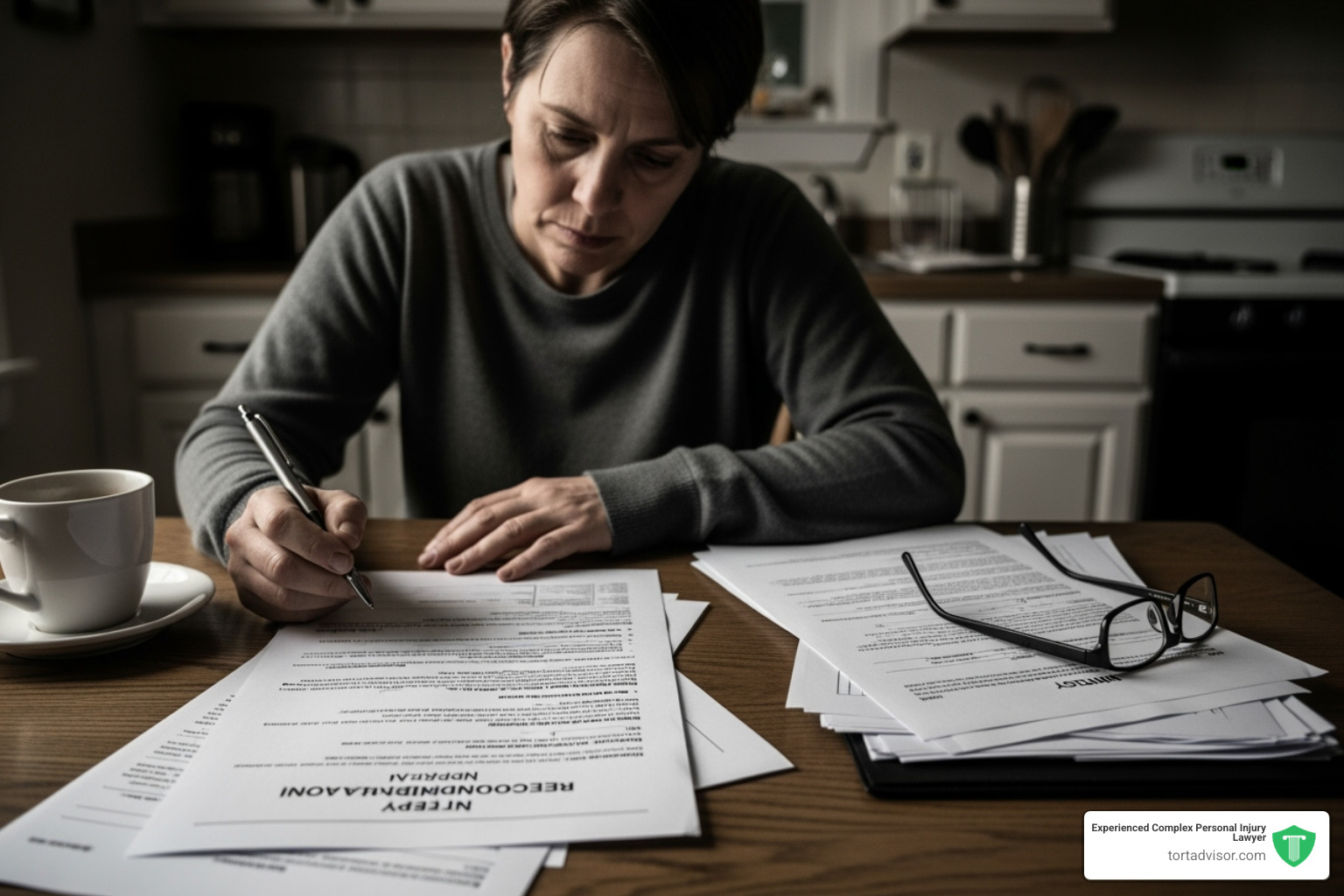


Understanding the SSDI Reconsideration Appeal Process
An SSDI reconsideration appeal is your first chance to challenge a denied Social Security Disability Insurance claim. If you’ve received a denial letter, you’re not alone—the Social Security Administration (SSA) denies about 70% of initial applications. This is a normal part of the process, not the end of the road.
Quick Facts About SSDI Reconsideration:
- Deadline: You must file within 60 days of receiving your denial notice.
- Success Rate: Only 10-13% of reconsiderations are approved.
- Processing Time: Approximately 6 months (183 days) on average.
- Required Forms: SSA-561 (Request for Reconsideration), SSA-3441 (Disability Report – Appeal), SSA-827 (Authorization to Disclose Information).
- Cost: Filing is free, though you may choose to hire a lawyer.
The reconsideration appeal is the first of four levels in the appeals process. While the approval rate at this stage is low, it’s a mandatory step that protects your original application date and potential back pay. If your reconsideration is also denied, you can request a hearing before an Administrative Law Judge (ALJ), where the approval rate jumps to approximately 47%—especially for claimants with legal representation.
Understanding how to strengthen your case is key. This guide will walk you through each step of filing your appeal and show you how to build the strongest possible case for the benefits you deserve.
Understanding Your Denial: The First Step in the Appeals Process
Only about 30% of SSDI claims are approved at the initial level, meaning most applicants receive a denial. This isn’t a judgment on your disability’s validity; it’s a standard part of a complex system. A denial is not the end, but rather a common starting point for the appeals journey.
An SSDI reconsideration appeal prompts the SSA to conduct a fresh review of your case. A new claims examiner—someone not involved in the first decision—will evaluate your original evidence plus any new documentation you provide. This is your opportunity to fill in any gaps and directly address the reasons for the initial denial.
For more information, the SSA provides guidance on their “Understanding Supplemental Security Income (SSI)—Appeals Process” page, which has similarities to SSDI appeals.
Medical vs. Technical Denials
To build a strong appeal, you must first understand why you were denied. Denials fall into two categories:
Medical denials are the most common. They occur when the SSA determines your condition doesn’t meet their strict definition of disability. They might believe your evidence doesn’t prove you can’t work, your condition isn’t severe enough, or it won’t last at least 12 months. For a medical denial, your appeal must focus on strengthening your medical evidence with updated records and detailed doctor’s statements.
Technical denials are unrelated to your medical condition. They happen due to administrative issues, such as not having enough work credits for SSDI, having income or assets that exceed SSI limits, or earning too much money through “substantial gainful activity” (SGA). These can sometimes be fixed by correcting information or providing missing documents. However, if you lack sufficient work credits, an SSDI appeal won’t succeed, and you may need to explore other options like SSI.
| Type of Denial | Key Characteristics | Appeal Strategy Focus |
|---|---|---|
| Medical | Insufficient medical evidence, condition not severe enough, ability to perform other work | New medical records, doctor’s statements, RFC assessments |
| Technical | Not enough work credits, income/assets too high, engaging in SGA, administrative error | Correcting work history, clarifying income/assets, demonstrating cessation of SGA |
Why Appealing is Better Than Re-applying
It may be tempting to start over with a new application, but appealing is almost always the better strategy. Here’s why:
First, appealing protects your original application date. If your claim is eventually approved, this date is used to calculate your back pay. Reapplying resets this date, potentially costing you months or even years of benefits. This back pay can amount to thousands of dollars, so preserving your application date is financially critical.
Second, an appeal forces you to address the specific weaknesses in your initial claim. When you reapply, you might repeat the same mistakes. An appeal, however, allows you to target the exact reasons for denial and fix them.
Finally, while only about 13% of reconsiderations succeed, this step is necessary to reach the hearing stage with an Administrative Law Judge, where nearly 47% of claims are approved. The appeals process is designed to give you multiple chances to prove your case, and persistence is often the key to success.
How to File Your SSDI Reconsideration Appeal: A Step-by-Step Guide
Filing your SSDI reconsideration appeal is a manageable process if you follow the steps and, most importantly, meet the deadline.
You have 60 days from the date you receive your denial notice to file a reconsideration request. The SSA assumes you receive the letter five days after the date printed on it, which is when your 60-day clock starts. Missing this deadline can jeopardize your entire claim, forcing you to reapply and lose your original application date and potential back pay. If you are near the deadline, file immediately; you can submit additional evidence later.
You can start your appeal directly on the SSA’s website by using their “Request reconsideration” portal.
Required Documentation for Your SSDI Reconsideration Appeal
To file your appeal, you must complete three key forms:
- Form SSA-561 (Request for Reconsideration): This is your formal request. Clearly state that you disagree with the decision and explain why. Be specific about any evidence you believe was overlooked or misunderstood.
- Form SSA-3441 (Disability Report – Appeal): This form updates the SSA on your condition since your initial application. List any new diagnoses, doctor visits, hospitalizations, or medications. This helps demonstrate how your disability has progressed.
- Form SSA-827 (Authorization to Disclose Information): This form gives the SSA permission to obtain your medical records directly from your healthcare providers. List every doctor, clinic, and hospital that has treated you to ensure the SSA has access to all relevant evidence.
In addition to these forms, gather any new medical records created since you first applied, especially those from the last 90 days. Detailed doctor’s statements explaining your work-related limitations can also be incredibly persuasive.
Filing Your Request: Online, Mail, or Fax
The SSA offers three ways to submit your appeal:
- Online: This is the fastest and most recommended method. You can start a disability request on the SSA website, which provides immediate confirmation of submission and a re-entry number to save your progress.
- Mail or Fax: You can download and complete Form SSA-561-U2 and send it to your local Social Security office. If you choose this method, use certified mail with a return receipt to get proof of delivery.
- In Person: You can also file at your local Social Security office, which allows you to get a stamped receipt as immediate proof of filing.
No matter how you file, keep copies of everything you submit. A complete paper trail, including submission dates and confirmation receipts, is your best defense against lost documents or procedural questions down the line.
Building a Winning Case: How to Strengthen Your Reconsideration
Once you file your SSDI reconsideration appeal, your goal is to provide the new evidence needed to reverse the denial. The case will be reviewed independently by a new examiner, giving you a fresh start.
The key is to submit “new and material” evidence—information that wasn’t available during the initial review and is relevant to your disability. This includes documentation of a worsening condition, new diagnoses, or recent treatments. It’s also vital to follow your doctor’s prescribed treatment plan. The SSA wants to see you are actively managing your condition. If you have a valid reason for not following treatment, such as cost or access issues, be sure to explain this in your appeal.
One of the most effective pieces of evidence you can provide is a Residual Functional Capacity (RFC) form completed by your doctor. This form translates your medical condition into specific work-related limitations (e.g., how long you can sit, how much you can lift), which directly answers the questions the SSA examiner needs to assess.
Gather all new medical records, including recent test results, specialist reports, therapy notes, and hospital records. The more recent the evidence, the more weight it carries. If you need help organizing your claim, services offering disability claim assistance can be a valuable resource.
The Role of a Disability Lawyer
Statistics show that applicants with legal representation are three times more likely to win their disability case. A disability lawyer understands what evidence the SSA finds persuasive and can work with your doctors to obtain detailed reports and RFC forms. They manage all communications with the SSA, ensure deadlines are met, and build a legal strategy custom to your specific denial.
Even though reconsideration doesn’t involve a hearing, a lawyer’s involvement signals to the SSA that you are serious about your claim. If your reconsideration is denied, you will already have legal representation in place for the ALJ hearing, where your chances of success are much higher.
Understanding the Success Rate of an SSDI Reconsideration Appeal
It’s important to be realistic about the odds. Only about 13% of SSDI reconsideration appeals are approved. This stage is the toughest part of the process.
However, reconsideration is a mandatory step to get to the next level: the Administrative Law Judge (ALJ) hearing. At the ALJ hearing, the approval rate jumps to approximately 47%. This is where you can testify in person and have a lawyer present your case and cross-examine vocational and medical experts.
These numbers show why persistence is crucial. Many successful claimants were denied at reconsideration but went on to win their case at a hearing. View reconsideration not as a final verdict, but as a necessary step on the path to approval.
After You File: The Reconsideration Timeline and Next Steps
After submitting your SSDI reconsideration appeal, the waiting period begins. The national average processing time is approximately six months (183 days).
Your case is sent to your state’s Disability Determination Services (DDS) office, where a new claims examiner and medical consultant will conduct a full review of your original file and all new evidence.
During this time, the examiner may contact your doctors for more information. In some instances, the DDS may require you to attend a consultative examination (CE). This is an exam with an independent doctor paid for by the SSA to gather more current medical information. It is critical that you attend any scheduled CE, as missing it can lead to an automatic denial of your appeal.
Continue with your medical treatment and keep all records of appointments and symptoms. Any new documentation of your condition should be submitted to the SSA as soon as you receive it.
If Your Reconsideration is Approved
If your appeal is successful, you will receive a notice of approval. Your monthly benefit payments will start soon after. Your first payment will likely include a lump-sum back pay award, covering the period from your disability onset date (minus a five-month waiting period) to your approval. The letter will detail your monthly benefit amount and the total back pay you are owed.
If Your Reconsideration is Denied
Given that about 87% of reconsiderations are denied, receiving another denial is a very real possibility. If this happens, do not give up. This is a common outcome and a stepping stone to the next, more promising stage of appeal.
Your denial letter, the notice of reconsidered determination, will explain the decision and inform you of your right to request a hearing before an Administrative Law Judge (ALJ). You have 60 days from receiving this notice to file your request for an ALJ hearing. This deadline is firm.
The ALJ hearing is a significant opportunity. You will appear before a judge who has had no prior involvement in your case. You can testify directly about how your disability impacts your life, and your lawyer can present evidence and question witnesses. The approval rate at the ALJ hearing level is approximately 47%—a substantial increase from the reconsideration stage. With legal representation, your odds improve even further.
Frequently Asked Questions about SSDI Reconsideration
How much does it cost to file an SSDI reconsideration appeal?
Filing an SSDI reconsideration appeal with the Social Security Administration is free. If you hire a disability lawyer, they typically work on a contingency fee basis. This means you pay nothing upfront, and the lawyer only gets paid if you win your case. By law, the fee is limited to 25% of your back pay, with a maximum cap of $7,200. This structure ensures legal help is accessible to everyone, regardless of their financial situation.
Can I submit new evidence after I’ve filed my reconsideration request?
Yes, and you absolutely should. You can and should submit new medical evidence throughout the entire reconsideration process, right up until a decision is made. This is a critical part of strengthening your SSDI reconsideration appeal. Submit any new test results, reports from specialists, summaries from doctor’s visits, or records of hospitalizations as soon as you get them. This new information can provide the proof needed to overturn a denial.
What happens if I miss the 60-day deadline to appeal?
Missing the 60-day deadline can result in the dismissal of your appeal. However, you can file a late appeal if you can show “good cause” for the delay. You must provide a written explanation for why you were late. The SSA considers reasons that were beyond your control, such as:
- You were seriously ill or hospitalized.
- A death or serious illness in your immediate family occurred.
- You never received the denial notice.
- You were given incorrect information by an SSA employee.
If the SSA accepts your reason, your appeal will proceed as if it were on time. If they reject it, you will have to start over with a new initial application, which means you will lose your original application date and any potential back pay associated with it. If you miss the deadline, it is highly advisable to consult a disability lawyer to help you argue for good cause.
Don’t Face the SSA Alone: Get Expert Legal Help
Navigating the SSDI reconsideration appeal process is complex and can be overwhelming, especially while managing a health condition. You do not have to handle this challenge by yourself.
The statistics are clear: while only 10-13% of reconsiderations are approved, the success rate at the ALJ hearing stage jumps to nearly 47%. Furthermore, applicants with legal representation are three times more likely to win their case. An experienced lawyer knows how to build a compelling case, gather the right medical evidence, and effectively represent you before the SSA.
That’s where Tort Advisor can help. We connect people with highly skilled Social Security Disability attorneys who have proven track records of success. These specialists understand the system and can give your claim the best possible chance of approval.
We offer a free case evaluation with no obligation. Because our network of attorneys works on a contingency fee basis, you pay no fees unless you win your case. Your denial letter is not the final word.
Take the next step to secure the benefits you deserve. Contact Tort Advisor today to connect with an experienced attorney and give your claim the fighting chance it needs.
Free Confidential Case Evaluation
Complete the short form below to get an immediate FREE case review with an expert in your specific claim. Don't wait, your case could be time sensitive to file a claim.
Related Posts
Did a North Dakota product cause harm? Understand product liability, your rights, and how to take action for defects.
Get justice for clergy abuse. Find an expert Priest abuse lawyer to navigate complex laws and hold institutions accountable.
Diagnosed with meningioma after Depo-Provera? Understand potential Depo-Provera lawsuit settlements, risks, & how to claim compensation.
Uncover the truth about uber sexual assault cases. Learn about the alarming scale, Uber's accountability, and legal options for justice.
Facing wildfire losses? Discover the best wildfire lawsuit attorneys in California to fight for your full recovery and justice.
Exposed to Roundup & diagnosed with NHL? Discover how to sue Monsanto, understand eligibility, & seek compensation. Your guide to justice.









